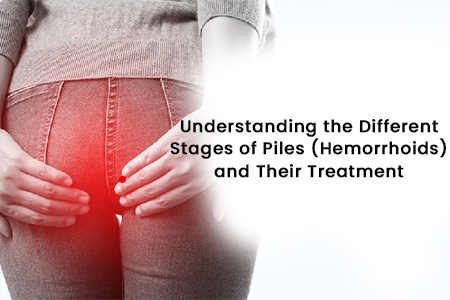Piles, also known as hemorrhoids, are swollen veins in the anal canal and rectum that can cause discomfort and pain. The condition progresses through different stages, each requiring specific treatment approaches for effective management. Here’s a breakdown of the stages and corresponding treatments:
Stage 1: First-Degree Hemorrhoids (Internal)
Description: These hemorrhoids are small and usually inside the rectum. They may bleed but do not protrude outside the anus.
Treatment:
Dietary and Lifestyle Modifications: Increasing fiber intake, drinking plenty of fluids, and avoiding prolonged sitting or straining during bowel movements.
Topical Treatments: Over-the-counter creams or ointments containing witch hazel or hydrocortisone to reduce itching and inflammation.
Sclerotherapy: Injection of a chemical solution to shrink the hemorrhoid.
Stage 2: Second-Degree Hemorrhoids (Internal)
Description: Hemorrhoids that prolapse (protrude) through the anus during bowel movements but retract back on their own.
Treatment:
Rubber Band Ligation: Placement of a rubber band around the base of the hemorrhoid to cut off its blood supply, causing it to shrink and fall off within a few days.
Infrared Coagulation: Using heat to coagulate the blood vessels feeding the hemorrhoid, which causes it to shrink.
Diet and Lifestyle Changes: Similar to Stage 1, focusing on increasing fiber and fluid intake.
Stage 3: Third-Degree Hemorrhoids (Internal)
Description: Prolapsed hemorrhoids that require manual reinsertion back into the anus after bowel movements.
Treatment:
Hemorrhoidectomy: Surgical removal of the hemorrhoid tissue. It is typically performed under anesthesia and may require a brief hospital stay.
Stapled Hemorrhoidopexy: A procedure that uses a special stapling device to remove excess tissue and reposition the remaining hemorrhoidal tissue back into the anal canal.
Stage 4: Fourth-Degree Hemorrhoids (External)
Description: Prolapsed hemorrhoids that cannot be pushed back into the anus and are often accompanied by significant discomfort and bleeding.
Treatment:
Surgical Hemorrhoidectomy: Complete removal of the hemorrhoid tissue. This may be necessary if conservative treatments have not been effective or if complications arise.
Hemorrhoid Stapling: Used for certain cases of prolapsed hemorrhoids to block blood flow and reduce their size.
General Considerations for All Stages:
Pain Management: Over-the-counter pain relievers, sitz baths (sitting in warm water), and ice packs can help alleviate discomfort.
Preventive Measures: Maintaining good bowel habits, avoiding straining during bowel movements, and incorporating fiber-rich foods and adequate hydration into the diet can prevent recurrence.
Conclusion
Understanding the stages of piles and their respective treatments is crucial for effective management and relief from symptoms. At Dr. Saraja’s Ayurvedic and Anorectal Centre, we offer personalized care that integrates Ayurvedic principles with modern medical techniques to address hemorrhoids comprehensively. Whether through dietary adjustments, herbal remedies, or minimally invasive procedures, our goal at our centre for Best Kshar Sutra Treatment in Hyderabad is to provide holistic treatment that promotes long-term health and well-being for our patients.

